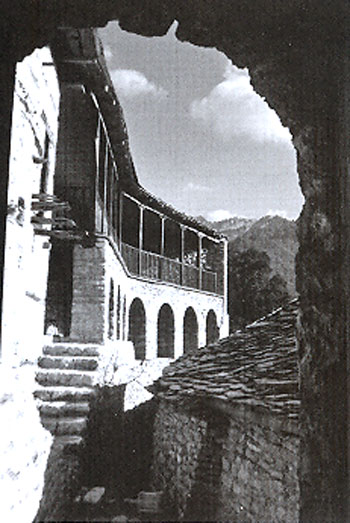
- The monastery of Katousiou
- Item ID : 438
- Collection Name : Holy Metropolis of Thessaliotidos and Fanariofersalon
- Category : Monastery
- Year : c. 1663AD
- Current Place : Katousi
- Description : The name got superseded by the settlement of the Transfiguration owned by the monastery and then called Katousiou.
The monastery is just over the border to Flourishing Karditsa and Trikala and at an altitude of 1200 meters. The monastery is dated c. 16nth AD and belongs to the Athonite type. The church is vaulted one without a dome , instead of which over the “soleas,” (part of the nave witch stretches in front of the sanctuary and slightly higher than the floor of the nave), in a circular hemisphere depicting the Pantocrator in the south and the north wall of the Catholic . The iconostasis was painted in 1661.
Painted on the ceilings and the arches, the frescoes are also divided into three zones. The first zone is the betrayal, Christ before Annas and Caiaphas, Christ the praetorium, the road to Calvary, the Crucifixion, the Deposition and Lamentation. In the second zone we see the resurrection of Lazarus, the Entry into Jerusalem, the Last Supper and the Washing of the Feet. Finally, the third area is the centre of the ceiling is: Jonah, Zechariah, and Micah.
In semi-vault dominates the imposing figure of the Pantocrator in Orthodox performances. Under the Almighty "Axion Esti" represented circumferentially, while in the second zone around the Pantocrator depicted the twelve prophets in all four corners (plumes or spherical triangles) and the four Evangelists. In the centre of the temple hangs a gilded carved wood "depiction" with twelve round corners and each corner hangs a picture illustrating one aspect of a prophet and the other an apostle.
Right and left of the church entrance, in the interior, depicted in full body are the archangels Michael and Gabriel.
On the west wall above the entrance the Assumption with the apostles is depicted and Christ at the top that holds the white soul of Mary. Above the image is the Assumption of Mary.
In the upper zone of the right place the Transfiguration and the corresponding part of the left part ,the Resurrection of the Lord are represented. In the last fresco Christ holding the right hand of Adam and Eve s left.
Right and left David and Solomon respectively, and many other saints are represented , whileat the top and bottom of the Christ is flanked a pair of angels.
In the sanctuary murals are also three zones. The main ones are as follows : On the north wall , the Resurrection , the rolling of stone by angels, the Myrrh bearing , the palpation of Thomas and te liturgy of angels.
In the lower zone Peter of Alexandria is depicted , conversing with Jesus which is depicted a s a twelve year boy.
On the roof of the temple: The Ascension , The Pentecostal , the Feast of the Annunciation , Iasaias, Moses, David and Joel are represented.
In the sanctuary below Platitera, a series of prophets are depicted, in another series, the Transmission and Communion and the third series the saints Athanasius, Chrysostom, Basil and Gregory are presented.
In the niche of the diakonikon (in Byzantine churches a chamber to the south of the sanctuary serving as sacristy or vestry), is a rare mural. Christ is depicted in the form of young male and angel form with two wings and below the inscription: "The Angel of Great Counsel."
Finally, in the south wall of the sanctuary illustrated: The Birth of the Virgin, the Presentation, the scale of Jacob and in another zone the Nativity of the Lord, the Presentation and the Baptism.
From paintings of Holy Table, of particular interest , causes us a mural paintoing, depicting Saint Christopher with dog head, as the tradition wants.
Painters of the monastery as seen from the inscriptions is John, the priest Anastasius, Dimitrios Anagnostou and Constantine from Vrestinitsa are also illustrated.


